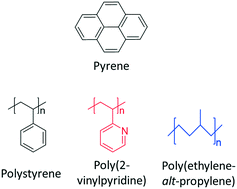Engineering the crystallization behavior of an organic compound mixed with polymers using hidden liquid phase domains†
Abstract
The crystallization behavior of pyrene mixed with polystyrene, poly(ethylene-alt-propylene), or poly(2-vinylpyridine) is investigated using the differential scanning calorimetry (DSC) technique to understand the effects of polymers on the crystallization behavior of organic compounds. Extensive DSC characterization reveals that all the crystallization curves of pyrene as a function of polymer composition have upper critical crystallization temperatures. We believe the upper critical behavior suggests that the crystallization of pyrene in the polymer solutions are directed and assisted by the spinodal limits of the hidden liquid–liquid phase domains located inside the two-phase domains of pyrene crystals and polymer-rich liquid phases. We also observed that, for pyrene mixed with relatively non-polar polystyrene or poly(ethylene-alt-propylene), the crystallization temperature curves of pyrene shift with the melting temperature curves of pyrene crystals. This result is consistent with the classical Flory–Huggins theory which describes the thermodynamic behavior of polymer solutions using the chemical compatibility between the solvent and polymer. In contrast, the crystallization curve of pyrene mixed with relatively polar poly(2-vinylpyridine) is observed in the higher temperature domain despite the melting temperature curve of the pyrene crystals with poly(2-vinylpyridine) being shifted to the lower temperature domain due to the favorable chemical compatibility between pyrene and poly(2-vinylpyridine) compared to those with the other relatively non-polar polymers. We attribute the contrasting melting and crystallization behavior of pyrene in the poly(2-vinylpyridine) solutions to the high dipole moment of poly(2-vinylpyridine) that induces an enlarged hidden liquid phase domain due to the attractive interactions between poly(2-vinylpyridine) segments. These findings show that polymers are effective and versatile additives for controlled crystallization of organic compounds using the hidden liquid–liquid phase domains.

- This article is part of the themed collection: MSDE Emerging Investigators 2020


 Please wait while we load your content...
Please wait while we load your content...